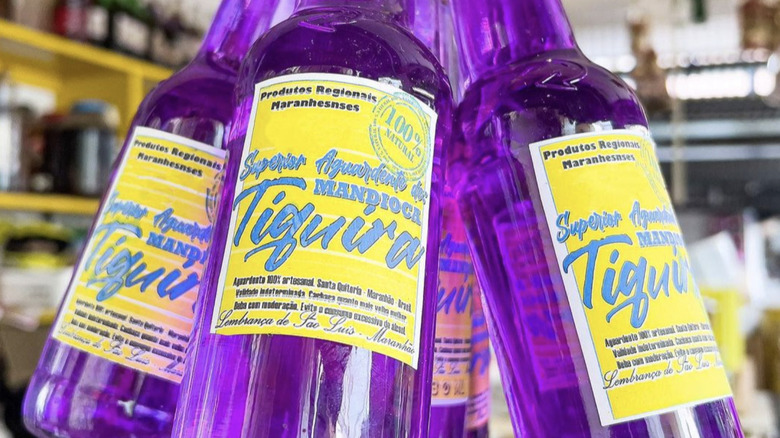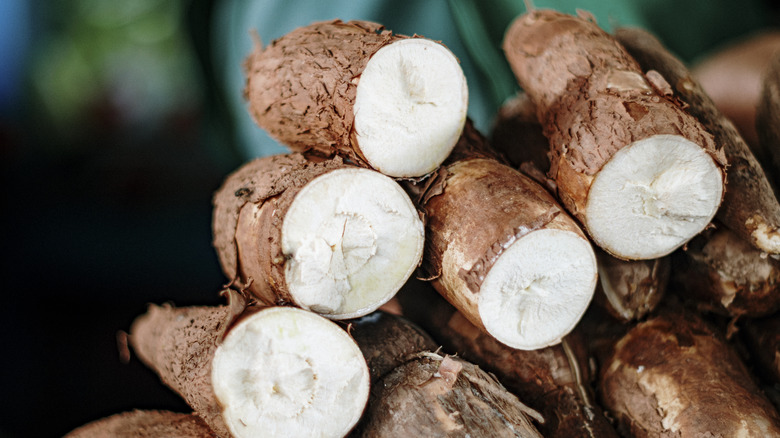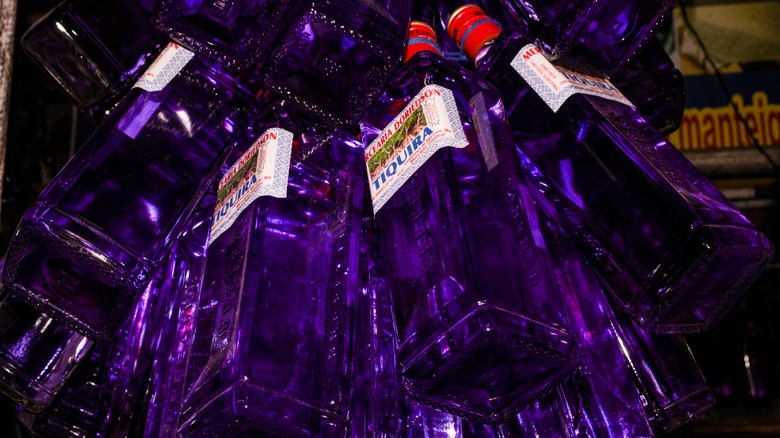The Interesting History Of Tiquira, One Of Brazil's Oldest And Rarest Spirits
If you see a bottle of vibrant violet-colored liquid sitting on shelves in Brazil, know that it's not medicine or a cleaning product — it's tiquira, the nation's oldest spirit. This strong liquor is made from cassava, a root vegetable native to the tropical region. Brazil is best known for cachaça, a fermented sugarcane juice liquor, that is the key ingredient of the caipirinha cocktail. But before the production of sugarcane, there was tiquira; for thousands of years, variations of the cassava-based drink have been made by Indigenous Brazilians. The spirit is most prevalent in Maranhão, a state located in the northwest of the country, with tiquera being lesser known throughout the rest of the country.
Cassava (also known as manioc or yuca) is toxic when raw, so it must be processed to remove the chemicals that convert to cyanide before consumption. To make the liquor, cassava root is first grated, pressed, and cooked to remove the toxins present. Then, it is fermented and distilled, resulting in a strong liquor registering between 38-54% ABV. The bright violet color comes from the infusion of tangerine leaves, although some producers use a dye instead.
History of tiquira
Indigenous groups in Brazil used cassava as a base for several alcoholic beverages that more closely resembled beer, including cauím, taruba, caxiri, and yakupa. Similar drinks like masato (Peru) and parakari (Guyana) can be found in other South American countries. Each of these drinks used cassava as the primary ingredient, but some variations include the addition of sweet potato, rice, sugar cane, fruit, and other local plants. To remove toxins, Indigenous people first chewed the cassava before fermenting it; the saliva and the natural yeast present on cassava worked to eliminate the toxins.
Initially, the cassava beer drink called cauím was produced in the region now known as Maranhão state, and mostly drank ceremonially. Cauím was transformed into a spirit with a high alcohol percentage when distilling techniques arrived in Maranhão. The name tiquira likely comes from ti-kyra, a word from the native Tupi people who live in this region, that means "liquid that drips," referring to the distillation process.
How to drink tiquira
While there are better-known drinks in Brazil like the Rabo de galo and caipirinha cocktail, tiquira can be found in markets throughout Maranhão. The bright violet-colored bottles hanging from market stalls will easily catch your eye. A Brazilian brand, called GUAAJA, commercially produces the liquor and distributes its globally. Interestingly, the company's tiquira does not have a bright violet color, but the varieties range from clear to a light amber color because tangerine leaves or dye are not added to the product.
However, the majority of tiquira that is produced today is made in the home illegally, best compared to what we call moonshine here in the United States. Instead of using the full cassava root, home producers often use cassava flour, which has already been processed with toxins removed.
If you decide to taste one of the country's oldest spirits, you'll need to learn all of the customs and superstitions that accompany it. One interesting way to consume it is to soak a cashew in the liquor for several hours, and then suck on the boozy nut. If you're taking shots of tiquira, avoid taking a shower or getting wet — it's believed that you could become "aluado", which means moonstruck in Portuguese.


